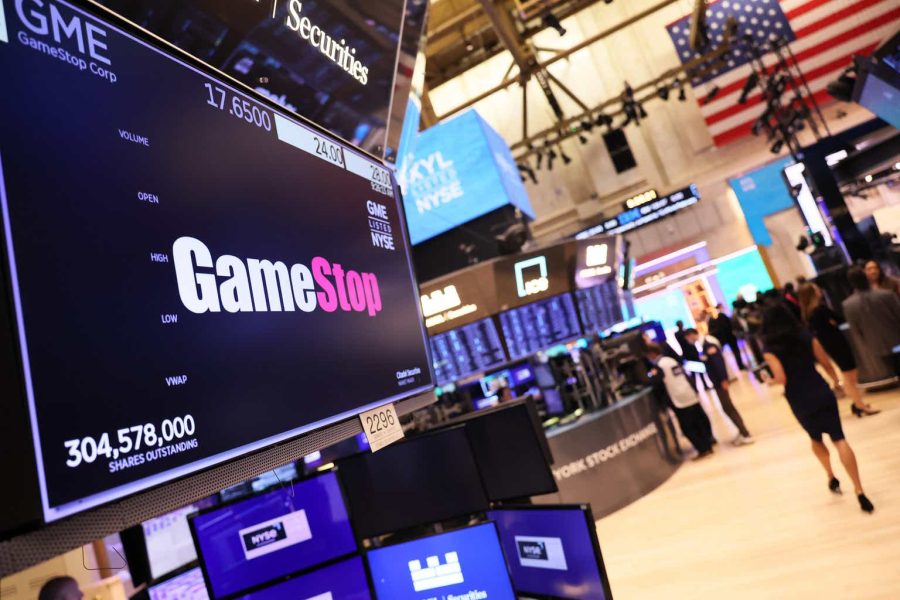Summary:
- I would steer clear of the GameStop stock – in every sense – both long and short.
- The fact that I have to mention this is a consequence for all serious market participants and potentially shows the damage to market transparency and efficiency to this day.
- GameStop does have some value, but it still lies well below its current share price. “Healthy shrinkage” leads back to profitability.
- Current valuation implies reduced contraction whilst significantly expanding margins.
- I have already covered other representatives of the gaming industry, including Nintendo and Take-Two Interactive.
Michael M. Santiago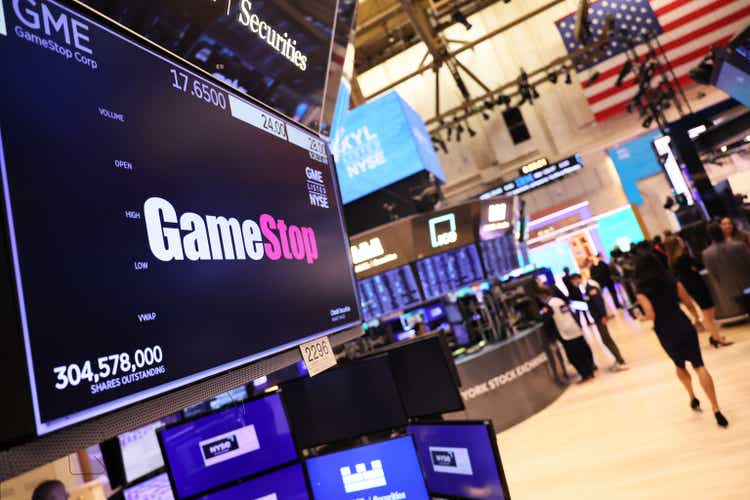
A Three-Year Long Ride Down Towards Fair Value
At about 15 USD a share two months ago, my attention was drawn back to GameStop (NYSE:GME) three years after its dramatic showdown between retail traders and hedge funds, which led to its erratic price movements. I suggested that in a highly optimistic scenario, the downside could at least drop to 10 USD, a level we have already witnessed. Now, given GME’s latest quarterly results, I conducted a more in-depth analysis of its current fair value. These are the key points of my thesis:
- I argue that although GME has already traversed the majority of its remarkably extended journey down from excessive peaks toward fair value, it still hasn’t reached its destination.
- The business model simply continues to offer little in terms of attractiveness.
- I compare the macroeconomic, monetary, and fiscal landscape during the height of the excesses with how fundamentally different it appears today.
- Most importantly, I conduct a simplified yet fundamentally-based valuation for GME, based on the most recent numbers.
Partially Charming, But Not A Sustainable Business Model
Looking into GME’s operational revenue segments over time, it is easily observable that their formerly high-margin segment of reselling second-hand gaming products has been in a consistent decline since 2012. This is not very surprising and points to a fundamental problem that is still valid today. Due to digital sales, often directly marketed through the gaming platforms’ in-house stores, the market for pre-owned video games should further decline significantly. And here we are not even discussing outsourcing computing power to cloud gaming, which could potentially render hardware obsolete in the future. With that, I also anticipate the existing games and hardware to consistently decrease in market value, despite some rare pieces that might gain vintage charm and value one day. Moreover, I see little rationale for someone to sell their old hardware cheaply to GameStop, which aims to profit from it, when it is easier than ever to sell through various reselling platforms privately, without intermediaries. “Our largest vendors are Sony, Nintendo, and Microsoft, which collectively accounted for a majority of our new product purchases in fiscal 2023″, an unsurprising fact according to GME’s 10-K filings that still leaves a very bitter taste, as it clearly indicates GameStop’s lack of market power or, conversely, the high power of its suppliers.
On the other hand, I believe that physical collectibles, as a counterpart to digitalization, might remain in demand among gaming and franchise fans. But “Collectibles also included our digital asset wallet and NFT marketplace activities in fiscal 2023; however, both activities were wound down in the fourth quarter of 2023,” it says in GME’s 10-K filings. Issues like these, on the other hand, make me less optimistic about seeing a serious long-term strategy in GameStop. They jumped onto the NFT bandwagon and shut it down shortly thereafter. In this context, I would like to point out another risk that GME itself has identified in its 10-K filings: High turnover in key leadership positions could lead to a lack of clarity in GameStop’s strategic direction. Coupled with high turnover rates in the retail and fulfillment sectors, this poses a risk to GameStop’s ability to attract and retain skilled personnel, including key executives, potentially affecting the company’s sustainable business development.
Looking at the formerly reported segment “digital”, it is evident that GameStop has never been able to significantly grow in this area. From my perspective, GameStop is therefore a nostalgic remnant of a relatively analog world, whose preservation would personally delight me, but which today does not show any promising prospects for a future business model.
GME revenue segments (Aktienfinder.net)
Macroeconomic Enablers of a Rollercoaster Ride
Some may still view GME differently than I do on a fundamental level, either through trading strategies or idealistic movements. But despite my support for democratizing the stock market, I do not at all see the GameStop events as beneficial to the cause. The “diamond hands” movement, while aiming to challenge the status quo, resulted in significant losses for many, with GME now trading almost 90% below its peak. Today’s trading volume is no more but a shadow of its 2021 frenzy, underscoring the transient nature of such movements. This episode, marred by manipulative tactics on both sides, underscores a power struggle without any lasting victors.
Certainly, herd-psychological and technical market mechanisms like Short Squeezes were at play. However, as a fundamental analyst, I am also interested in the broader context that may have facilitated these occurrences. One of the primary sources of “free money” enabling investors to engage in such behavior was monetary policy, with Fed assets doubling and interest rates being slashed in response to the pandemic. With this money, for instance, the US government was able to distribute funds like watering gardens via stimulus checks to the population. From March 2020 to March 2021, $814 billion flowed in three rounds, averaging 159 million payments per round. This amounted to a staggering 4% compared to the 2021 US Real GDP, or more than $5,000 per recipient.
multpl.com, FRED, investing.com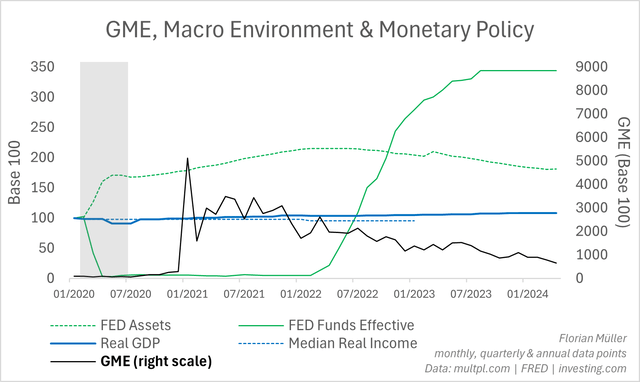
As we are all aware, the current environment is markedly different, with the Fed having reduced its balance sheet and having substantially raised interest rates since the outset of 2022. Therefore, I suspect that stimulus checks played a significant role in enabling retail investors to engage in such behavior. This is clearly not something to speculate about occurring again in today’s environment.
Accelerated Contraction During Holiday Season
For a long-term retrospective to 2017, I reassigned the old segments to the new structure at my discretion. Notably, the software segment shrunk annually by -14% over eight years. Due to the more stable performance of the other two segments, the total annual revenue decline during this period was -8%. After having established the new segment structure as of 2020, the shrinkage of the software segment was -20% annually and -7% at the corporate level. The dynamics of this contraction became even more pronounced in the last fiscal year compared to long-term averages, with an acceleration to -11% in total revenue, and the quarter-over-year comparison showed the most significant contraction, with -19% in total revenue or -24% in the software segment, despite this being the seasonally strongest quarter with Christmas holiday sales. “Our business (…) is seasonal, with the major portion of sales and operating profit realized during the fourth quarter of the fiscal year (…). (…) During fiscal 2023 and 2022, we generated approximately 34% and 38%, respectively, of our sales during the fourth quarter.” (GME 10-K Filings)
On a positive note, operational margins appear to have bottomed out two years ago and have since returned to breakeven on an annual basis, with a 3% net margin in the holiday quarter. Next, I optimistically assume that through a “healthy shrinkage”, GameStop will nearly reach old profitability levels with a 6% operational margin.
Author | Data: Aktienfinder.net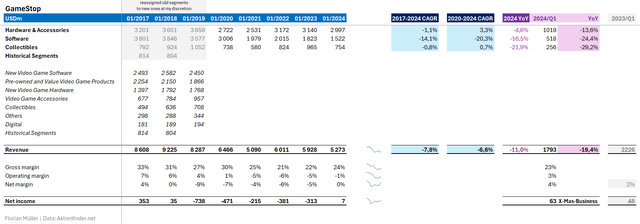
Investment Behavior Illustrating Shrinkage
For a simplified derivation of free cash flow, I particularly consider the depreciation to CAPEX ratio resulting from GameStop’s contraction. Historical data up to 2018 shows CAPEX exceeding depreciation aimed at growth, whereas since 2019 the company has fully embraced contraction, with depreciation consistently exceeding investments – most recently with a 63% CAPEX to depreciation ratio, or $20 million higher depreciation than investments. This results in a positive cash effect, contrary to the typical negative cash effect seen in growing companies that invest more than they depreciate. I will account for this positive cash effect in the subsequent calculation of free cash flow by adding the latest effect of $20 million to NOPLAT.
Fair Value With Optimistic Margins
Regarding the terminal growth rate, I rely on the historical revenue CAGR of -7.8% over the past eight years, given there are no signs of a turnaround toward fundamental business growth. While this might initially seem high, it’s still significantly lower than the accelerated contraction dynamics observed in the past year and the most recent quarter. In the sensitivity analysis, I also consider lower contraction rates, extending to a 0% growth scenario.
From all the assumptions discussed so far, a simplified company valuation emerges: Revenue x an optimistic future EBIT margin of 6% minus 25% taxes, plus the positive cash effect from low CAPEX requirements = free cash flow. The risk profile is marked by low country risk but a high 24M Beta factor of 1.8 (according to Seeking Alpha), leading to a WACC of approximately 11%. Adding the perpetual shrinkage assumption of around 8%, the Gordon Growth formula yields 19% in the denominator, resulting in a discounted value of FCF at 1.34 billion USD. Adding net cash, this yields a 1.94 billion USD equity value or 6.34 USD per share. Today’s market value of around 11 USD, for instance, implies a 10% EBIT margin goal with only -4% terminal contraction or an 8% EBIT margin with zero growth starting now. Both scenarios seem unrealistic from today’s perspective.
Author | Data: Aktienfinder.net, Seeking Alpha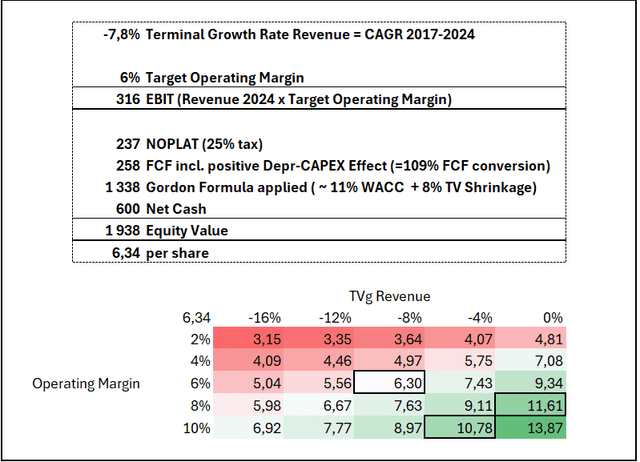
The assumption of perpetual decline logically doesn’t provide a basis for seeing GameStop as an investment case. In fact, this approach only accounts for the cumulative future earnings on today’s book value (recorded equity value). The book value is estimated at 1.34 billion USD.
Conclusion And Personal Perspective
This article was not written for traders or ideologically inclined activists who might interpret stock prices completely differently. From my very personal point of view, the GME madness was probably a lose-lose situation for all participants, with very few winners on the side of some “revolutionary” retail traders, who finally let each other down by taking profits themselves – not being better than others whom they accuse of market manipulation. From a fundamental perspective, GME’s current value is indeed already closer to what could be considered plausible in overly optimistic scenarios, but based on my assumptions, it remains significantly overvalued. This is without even addressing the broader question of whether investing in a shrinking business model makes sense. If you want to explore other aspects of the gaming industry, I’d be happy if you checked out my related articles on Nintendo (OTCPK:NTDOY)(OTCPK:NTDOF) and Take-Two Interactive (TTWO).
Analyst’s Disclosure: I/we have no stock, option or similar derivative position in any of the companies mentioned, and no plans to initiate any such positions within the next 72 hours. I wrote this article myself, and it expresses my own opinions. I am not receiving compensation for it (other than from Seeking Alpha). I have no business relationship with any company whose stock is mentioned in this article.
Seeking Alpha’s Disclosure: Past performance is no guarantee of future results. No recommendation or advice is being given as to whether any investment is suitable for a particular investor. Any views or opinions expressed above may not reflect those of Seeking Alpha as a whole. Seeking Alpha is not a licensed securities dealer, broker or US investment adviser or investment bank. Our analysts are third party authors that include both professional investors and individual investors who may not be licensed or certified by any institute or regulatory body.
